<< Previous | Displaying results 4701-4750 of 6769 for "" | Next >>
A child vendor among those selling miscellaneous wares at the market in the Lodz ghetto. Lodz, Poland, ca. 1941.
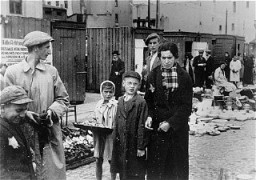
A column of prisoners arrives at the Belzec killing center. Belzec, Poland, ca. 1942. In early 1940 the Germans set up a forced-labor camp for Jewish prisoners in Belzec. The inmates were forced to build fortifications and dig anti-tank ditches along the demarcation line between Germany and Soviet-occupied Poland. The camp was closed down at the end of 1940. The following year, in November 1941, construction began on the Belzec killing center.
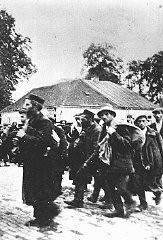
Aerial photograph showing the gas chambers and crematoria 2 and 3 at the Auschwitz-Birkenau (Auschwitz II) killing center. Auschwitz, Poland, August 25, 1944.
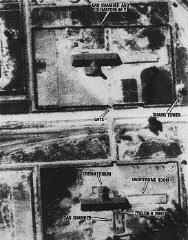
One of many warehouses at Auschwitz in which the Germans stored clothing belonging taken from victims of the camp. This photograph was taken after the liberation of the camp. Auschwitz, Poland, after January 1945.
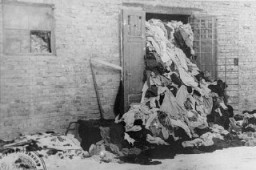
Jews assembled in the Siedlce ghetto during a deportation are forced to march toward the railway station. Siedlce, Poland, August 21–24, 1942.
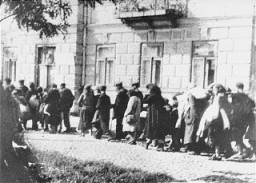
Jews from the Warsaw ghetto are marched through the ghetto during deportation. Warsaw, Poland, 1942–43.

Prisoners at forced labor building an extension to the camp. Auschwitz-Birkenau, Poland, 1942–43.

Aerial view of the Nuremberg Palace of Justice, where the International Military Tribunal tried 22 leading German officials for war crimes. Nuremberg, Germany, November 1945.
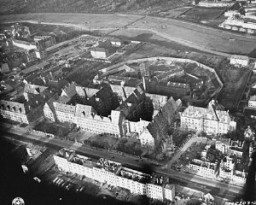
During the Nuremberg Trial, American guards maintain constant surveillance over the major Nazi war criminals in the prison attached to the Palace of Justice. Nuremberg, Germany, November 1945.
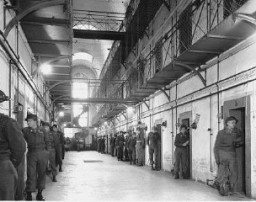
Survivors of Mauthausen cheer American soldiers as they pass through the main gate of the camp. The photograph was taken several days after the liberation of the camp. Mauthausen, Austria, May 9, 1945.
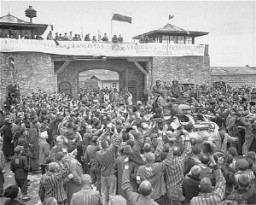
Members of a resistance organization in the camp meet with American soldiers in front of the entrance to the Buchenwald concentration camp. Buchenwald, Germany, after April 11, 1945. In early April 1945, as US forces approached the camp, the Germans began to evacuate some 28,000 prisoners from the main camp and an additional several thousand prisoners from the subcamps of Buchenwald. About a third of these prisoners died from exhaustion en route or shortly after arrival, or were shot by the SS. The…
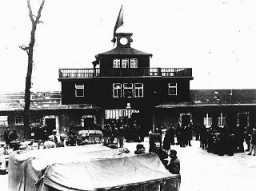
US soldiers enter the Buchenwald concentration camp following the liberation of the camp. Buchenwald, Germany, after April 11, 1945.
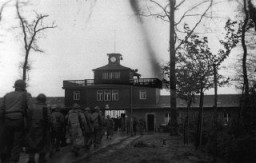
Prisoners carrying bowls in the Dachau concentration camp. Dachau, Germany, between 1933 and 1940.

Roll call at an internment camp for Roma (Gypsies). Lackenbach, Austria, 1940–41.
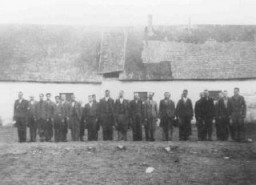
Prisoners of the Stupki forced-labor camp for Jews in the Generalgouvernement. Stupki, Poland, 1941–42.
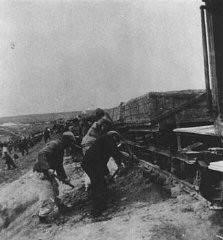
Prisoners at forced labor near the entrance to the Buchenwald concentration camp, Germany, 1937–45.

Prisoners at forced labor digging a drainage or sewage trench in Auschwitz. Auschwitz, Poland, 1942–43.
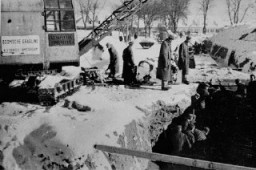
Fleeing the advance of the Soviet army, the Germans forcibly evacuated westward by barge these prisoners of the Stutthof concentration camp. Near Danzig, January 1945.
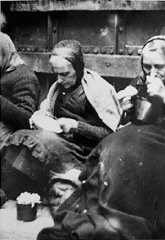
Crowds gathered in the streets of Tel Aviv celebrate the anniversary of the establishment of Israel with an independence day parade. Tel Aviv, Israel, May 1949.
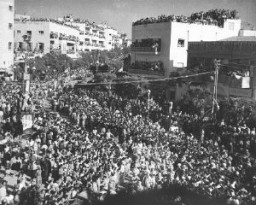
Members of a Polish family who hid a Jewish girl on their farm. Zyrardow, Poland, 1941-1942.
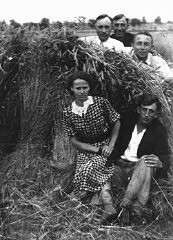
Photograph of a group of Jewish partisans. Sumsk, Poland, date uncertain.
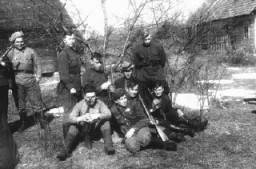
Jewish partisans, including a song and dance group, in the Naroch forest in Belorussia. In addition to armed resistance, Jewish resistance also focused on spiritual resistance—the attempt to preserve traditions and culture. Soviet Union, 1943.
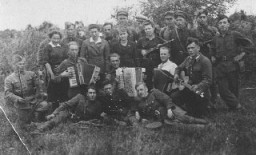
Group portrait of a Jewish French underground group named "Compagnie Reiman." This photograph was taken after the liberation of France. Paris, France, 1945.
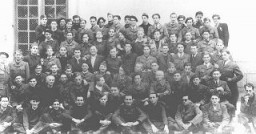
Yugoslav partisans with Jewish parachutists from Palestine. Yugoslavia, 1944.
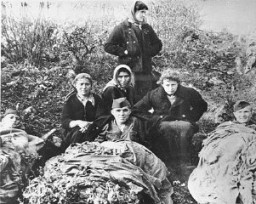
Deportation of Jews from the Warsaw ghetto. Jews from the ghetto board a deportation train with the assistance of Jewish police. Warsaw, Poland, 1943.
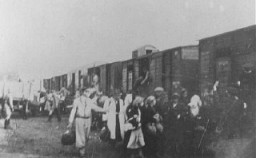
Juergen Stroop (third from left), SS commander who crushed the Warsaw ghetto uprising. Warsaw, Poland, between April 19 and May 16, 1943.
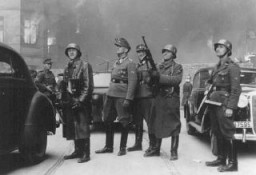
German soldiers capture Jews hiding in a bunker during the Warsaw ghetto uprising. Warsaw, Poland, April–May 1943.

Crematorium 4 under construction. This crematorium was later destroyed during an uprising in the camp. Auschwitz-Birkenau, Poland, winter 1942-1943.
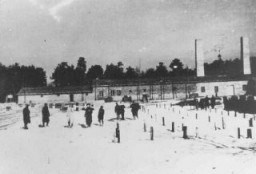
Modern techniques of propaganda—including strong images and simple messages—helped propel Austrian-born Adolf Hitler from being a little known extremist to a leading candidate in the 1932 German presidential elections. The style of this poster is similar to some of film stars of the era. Election poster, 1932; photo by Heinrich Hoffmann
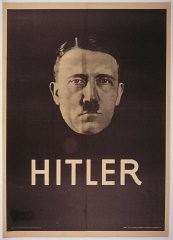
Hitler carefully cultivated his image as the Nazi Party leader as he came to see the propagandistic value of photographic publicity. Heinrich Hoffmann, Hitler’s official photographer, created the images central to the growing "Führer cult." In 1927, Hoffmann snapped action shots such as this one of Hitler rehearsing his oratory.

Poster: "Greater Germany: Yes on 10 April" (1938). This election poster emphasizes the message of jumping on the Nazi political bandwagon, as represented by the hands raised in a unified Nazi salute. Nazi propaganda frequently stressed the power of a mass movement to propel the country forward, subtly underscored by the upward angle of the hands. This poster typifies the propaganda strategy of using simple confident slogans, with bold graphics often using the characteristic Nazi colors of red, black, and…
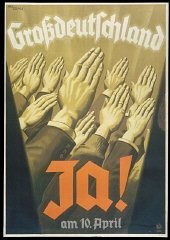
Poster: "We Women Are Voting Slate 2 National Socialists." German women were an important voting bloc. The Nazis made a concerted effort to appeal to women, as exemplified by this 1932 election poster. The Nazis had to repackage their messages to de-emphasize military aims. Hitler consciously modeled some Nazi propaganda appeals to German women on speeches delivered by Benito Mussolini in Fascist Italy, who also had to calm the fears of Italian war widows after World War I. Nazi propagandists attempted to…
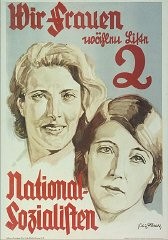
Nazi propaganda poster for 1932 elections, declaring Adolf Hitler to be the last hope of impoverished Germans.

Nazi propaganda often portrayed Jews as engaged in a conspiracy to provoke war. Here, a stereotyped Jew conspires behind the scenes to control the Allied powers, represented by the British, American, and Soviet flags. The caption reads, "Behind the enemy powers: the Jew." Circa 1942.

This photograph shows Julius Wolff, a young Jewish man, and Christine Neemann, his non-Jewish fiancé, standing between two police officers in Norden, Germany. Local SA men had accosted the couple and led them through the streets. The parade was meant to mock and humiliate the couple. Wolff wears a sign that reads: "I am a race defiler" ("Ich bin ein Rasseschänder"). Other photographs of this event show, and Neemann's testimony confirms, that Neemann was also forced to wear a sign. Neemann and Wolff…
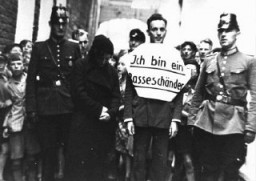
Poster promoting the Nazi monthly publication Neues Volk. Jews were not the only group excluded from the vision of the "national community." The Nazi regime also singled out people with intellectual and physical disabilities. In this poster, the caption reads: "This hereditarily ill person will cost our national community 60,000 Reichmarks over the course of his lifetime. Citizen, this is your money." This publication, put out by the Nazi Party's Race Office, emphasized the burden placed on society by…
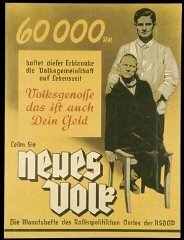
A Hitler Youth poses for a photograph in the Rhineland city of Bruehl, 1934. The Hitler Youth and the League of German Girls were the primary tools that the Nazis used to shape the beliefs, thinking and actions of German youth.
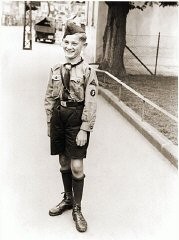
Poster: "Students/Be the Führer's propagandists." With militant appeals to nationalism, freedom, and self-sacrifice, the Nazi Party successfully recruited students disenchanted with German democracy and their current student organizations.

In Berlin, a German woman reads a copy of the Berliner Illustrierte newspaper, featuring photographs of Mussolini's official visit to Berlin in September 1937.
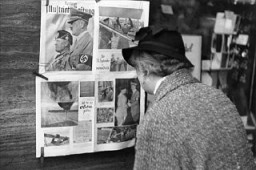
Front page of the most popular issue ever of the Nazi publication, Der Stürmer, with a reprint of a medieval depiction of a purported ritual murder committed by Jews.
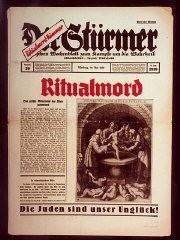
1936 poster: "All of Germany Listens to the Führer with the People's Radio." The poster depicts a crowd surrounding a radio. The radio looms large, symbolizing the mass appeal and broad audience for Nazi broadcasts. Bundesarchiv Koblenz (Plak003-022-025)

An antisemitic poster published in German-occupied Poland in March 1941. The caption reads, "Jews are lice; They cause typhus." This German-published propaganda poster was intended to instill fear of Jews among Christian Poles.
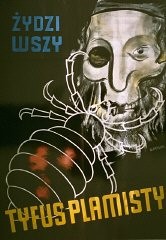
This poster from 1945 shows an embattled German family proclaiming, "Frontline City Frankfurt will be held!" A Frontstadt was a city Hitler declared must be defended against Allied attack at all costs. In the final months of the war, propaganda efforts were directed at rallying the populace for a final defense of the country.
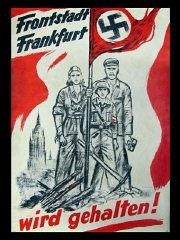
Poster: Nuremberg / Guilty! After the end of the war and the defeat of Nazi Germany, Allied occupation authorities in Germany used posters such as this one to emphasize the criminal nature of the Nazi regime.
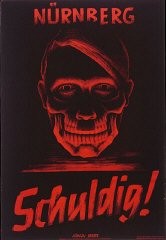
During World War II, the Nazi regime financed and facilitated anti-British and antisemitic broadcasts by the former Mufti of Jerusalem, Hajj Amin al-Husayni, an Arab nationalist and prominent Muslim religious leader, to mobilize support for Germany and the Axis among Muslims in the Balkans and the Middle East. At the close of the war, al-Husayni was arrested in the French occupation zone of Germany. After authorities moved him to France, al-Husayni fled to Egypt, where he continued to produce and…
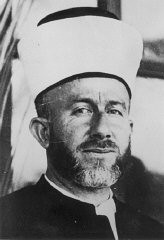
The Jacobsthal family poses with an aunt and uncle who are visiting their home in Amsterdam before emigrating to Chile. Amsterdam, The Netherlands, February 1938.

Cuban immigration papers issued to Ella Schatz, who had obtained passage aboard the Orinoco. On May 27, 1939, the Orinoco left Hamburg with 200 passengers bound for Cuba. Informed by radio of the difficulties other ships carrying refugees were facing in Havana, the captain of the Orinoco diverted the ship to waters just off Cherbourg, France, where it remained for days. The 200 refugees ultimately returned to Germany in June 1939. Their fate remains unknown.
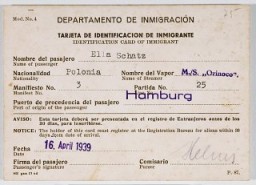
View of a bridge spanning a canal in Nuremberg. The houses and bridge are decorated with Nazi flags and banners. Photograph taken by Julien Bryan in Nuremberg, Germany, 1937.
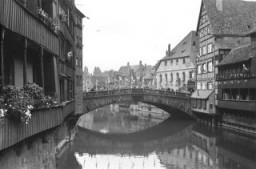
Julien Bryan was an important US documentary filmmaker and photographer who captured the everyday life, work, and culture of individuals and communities in many countries around the globe. Bryan was filming in western Europe in the summer of 1939. In the first week of September 1939, Bryan made his way to Warsaw just as all foreign reporters, diplomats, and Polish government officials were fleeing the capital in the wake of the German invasion. One of the few foreign photographers left in the city, he…
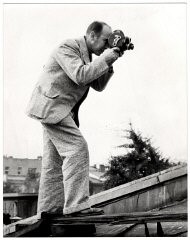
View of the smoldering ruins of a building in Warsaw following a German aerial attack. Warsaw, Poland, September 1939.
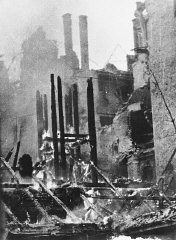
We would like to thank Crown Family Philanthropies, Abe and Ida Cooper Foundation, the Claims Conference, EVZ, and BMF for supporting the ongoing work to create content and resources for the Holocaust Encyclopedia. View the list of donor acknowledgement.